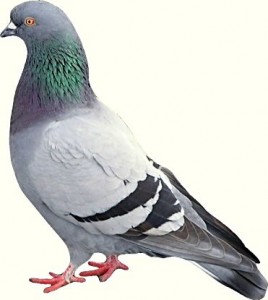 Pigeons are passerine birds in the Columbidae family, which is widely spread across the world. Like other passerines, pigeons have uniquely designed feet which allow them to perch, along with characteristically plump bodies, stubby beaks and legs, and small heads. Pigeons come in a wide variety of sizes and colors. Some pigeons have drab brownish to gray plumage, while others come in an array of tropical colors like green, yellow, and red.
Pigeons are passerine birds in the Columbidae family, which is widely spread across the world. Like other passerines, pigeons have uniquely designed feet which allow them to perch, along with characteristically plump bodies, stubby beaks and legs, and small heads. Pigeons come in a wide variety of sizes and colors. Some pigeons have drab brownish to gray plumage, while others come in an array of tropical colors like green, yellow, and red.
During mating season, pigeons build small, lightweight nests, laying two eggs which the parents incubate together. When the chicks hatch, the parents feed them on crop milk, a highly nutritious secretion of their crops. Crop milk is unique to members of the Columbidae family and the flamingos.
Raising pigeons nowadays is not only a good hobby but also a good source of income too. Pigeons multiply fast if proper care is given, and almost every part of a pigeon has use. For instance, the feathers and bones, after flesh meat has been removed, can be used as feed for chicken; its manure is feed for cows.
At the start, allow the pairs of pigeons in their new home. If they are not paired, place together equal number of male or female.
- Provide clean food and water everyday.
- 2. Always keep their coop clean.
- Separate immediately the sick or sick-looking ones.
- In preparing for egg laying, scatter leaves in their coop before the mother bird lays eggs otherwise eggs may be lost among the leaves and never be hatched.
Keep note (record) of the day of egg laying, hatching, number of chicks and their weight each, and number of deaths. This is important in removing those that are not productive and those that are poor in appetite and in growth.
A month after hatching, the chick should weigh 500 grams or more.
How to raise Pigeons
Feeding
1. If their feed is grains or commercial feed, they should be:
- whole grains, not fine or powdered
- the mixture must be adequate in vitamins
- free from molds, weevil, pest or damage
2. Feed may consist of corn, sorghum, soybean, rice or legume seeds (mongo).
3. Put the food in a place where they can eat all day. Separate grains from feed.
4. When raised in quantity, allow them to eat plenty until they hatch their eggs.
As the chicks grow, allow them to eat freely so as to grow fast and get sold quickly.
If they do not get sold within a month from hatching, or they lose weight, place them in a coop where their movement will not be so free, and give them plenty of food so as to grow fast.
Selling qualities are:
- 1st class — 500 grams
- Broiler — not older than 50 days
- Free from bruises and wounds or insect bites
- Feathers are clean and bright
Baths
Pigeons like to take a bath, so they must have their own bathing containers with about 7.5 cm deep water. They bathe 2 or 3 times a week in the morning if the weather is good. Remove the bath after they are through. Provide also clean sand (from the seashore) where they can roll themselves and pick up small shells and stones. When pigeons bathe often, they become sturdy against pests. Protect them from pests and diseases, and consult a veterinarian for this.
Reduction of Old Pigeons
Every year, remove 25% of old birds and replace them with newly born ones to keep active their propagation. Take care of half of this number until age 5-6 weeks. A progressive mother pigeon can produce 10 chicks a year.
Source: elgu2.ncc.gov.ph; Photo: clouddragon.wordpress.com